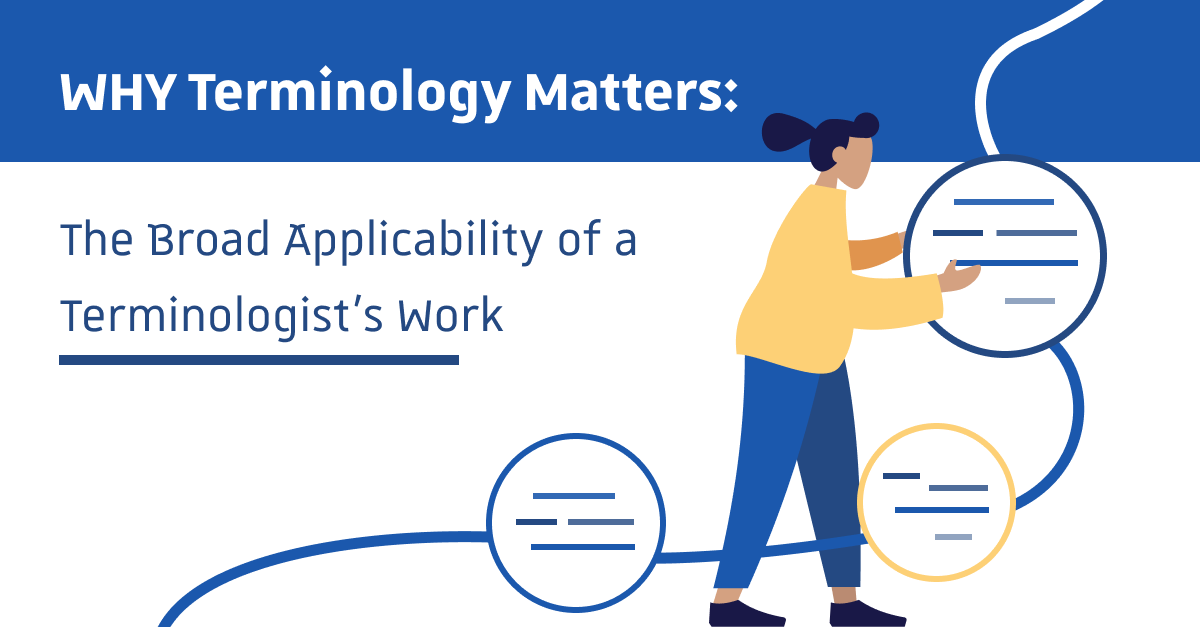Most language professionals might be working as translators, interpreters, or technical writers. But there is another relatively unknown profession: terminologist – the person who works with terminology. Terminology management comprises a variety of processes and tasks. It is the systematic collecting, storing, managing, importing, exporting, publishing, and maintaining of terminology in dedicated software, a so-called terminology management system.
I have been working as a multilingual terminologist in the medical technology industry for five years. Sharing my experience will give you an insight into my exciting work that goes beyond the benefits of traditional terminology management.
What Skills Does a Terminologist Need?
Although there are many paths to becoming a terminologist, a background in linguistics or translation qualifies you best for this demanding work. Furthermore, being a terminologist requires an eye for detail and the ability to research, analyze, and evaluate potential terms. As writing definitions comprises an important part of the daily work, being a clear and concise writer is a plus.
Broad expertise in the subject matter is not mandatory, as there are enough subject matter experts in the company. Your strength is language. During onboarding and employment, you will be trained on the subject matter.When managing terminology in multiple languages, a terminologist of a particular language must have excellent language expertise, know the cultural conventions, and involve subject matter experts in the corresponding country or language.
The Terminology Coordination Unit of the European Parliament published a professional profile for terminologists and a list of universities where terminology is taught.
Broader Applicability of Terminology Data
Traditionally, terminology management has been closely related to technical communication and translation. Hence, state-of-the-art CAT tools support the integration of termbases into a translation or localization project.
For more information on CAT tools, read A Beginner’s Guide to CAT Tools.
Progressive terminology management goes beyond traditional technical communication and translation. Terminologists have to offer more than that if they want to rise to prominence and be successful in a company as well as find new ways of using terminology data and their expertise.
Advanced help authoring tools and content management systems support the import of your terminology data. Check which format works best. Computational linguists on the team can write scripts to automate processes, for instance, for various termbase exports or data cleanup.
There is a trend towards machine translation and post-editing in the localization industry. Multilingual terminology data facilitates to train a machine translation engine and to achieve better quality. Although off-the-shelf solutions have significantly improved over the last years, they do not include specialized vocabulary. For further information on machine translation post-editing, please read this blog post.
Provide your multilingual terminology data to improve the search functions of user assistance, internal knowledge bases, or internal search engines. Thanks to prescriptive terminology management – stating which term is preferred and which is deprecated – users will find the right result, even if they entered a “forbidden” term in the search field.
The creation of glossaries is often in demand. A development team might ask you for the collection of all terms that apply to a certain product. Adapt the metadata model for your terminology management system according to your needs. This allows you to create specific glossaries to serve different target groups.
Terminology data is useful when creating digital learning content. If the responsible colleagues are graphic designers and non-professional writers, they will be glad if you support them by providing them with a glossary or by performing a terminology review. Keep in mind that not everyone who creates content is using a powerful help authoring support tool like professional technical writers would
Ideally, software developers should also use the agreed and approved terminology when writing code. Encourage them to use what is already available. Ask them in which format they would like to receive the terminology data. Include them in the approval process of software terms.
In the past, terminologists just maintained flat lists with the established terminology. Nowadays, advanced terminology management systems allow maintaining multilingual terminology data in complex, hierarchical structures. There is a tendency to combine taxonomy and terminology to share knowledge. You can define hierarchical and non-hierarchical relationship types between terms. The most common hierarchical relationships are between broader and narrower terms (e.g., a bread knife is a kind of knife, a steering wheel is part of a car, German is a language). A non-hierarchical relationship can be the one between antonyms (e.g., enable and disable).
Other departments might approach you because they are looking for a repository that displays a navigable tree view for hierarchically structured data.
If terminologists offer this visualization of terms through classification and proper relationships, they contribute to knowledge management in the company.

Tips for Successful Terminology Management
- Familiarize yourself quickly with the subject matter and deepen your knowledge.
- Involve colleagues in other countries and language regions in the approval of multilingual terminology. They are generally happy to contribute to the improvement of translation quality.
- Publish the terminology data internally. Make it accessible to all employees in all countries.
- Provide a feedback channel for terminology-related requests within the company.
- Be competent, friendly, and persuasive. Give a rationale for your proposals. There will always be people that are very resistant to change, even if the change is an improvement.
- Listen to other people’s opinions and remain open to criticism.
- Make yourself visible across departments and engage in networking.
- Develop your knowledge of language technology.
- Learn XML, especially TBX for termbase exchange and TMX for equivalents research.
- Hire a terminologist that knows natural language processing with Python. This enables automatizing numerous tasks, which increases efficiency.
- Gain competence in knowledge management.
- Stay curious and be willing to learn new things.
- Stay current with the latest tools and technologies.
For more articles on a variety of topics, visit the TCLoc blog.
If you are interested in the latest news, follow Master TCLoc on LinkedIn, Twitter, and Facebook.



